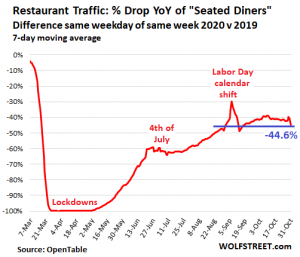
By Wolf Richter
Eight months into the Pandemic, about 78% of the US restaurants that had taken reservations before the Pandemic took reservations again during the last week in October, the highest since the start of the Pandemic, according to data from OpenTable. This does not include fast-food restaurants, delis, drive-throughs, cafés, and other types of eateries that never took reservations.
But “seated diners,” another metric provided by OpenTable, has dropped to the worst reading since September 19, perhaps due to the surge in Covid-19 cases, with some cities – we’ll get to them in a moment – showing a pronounced decline. This metric represents the percentage drop of the number of people (walk-ins and those with reservations) who ate in restaurants compared to the same weekday in the same week last year. As of October 31, the seven-day moving average of “seated diners” was down 44.6% from the same period last year:
The reading of -100% in the chart above during the lockdowns in April means that the guest count had plunged to essentially zero because restaurants were closed.
OpenTable’s data on seated diners is based on a broad sample of 20,000 restaurants that shared that information with OpenTable.
Restaurants in most places have offered outside-dining for months. Inside dining is more restricted. In many places where inside dining is offered, it comes with limits, such as diners cannot exceed 25% or 50% of capacity, and the bar areas might be closed, which makes it tough to run a restaurant, even in survival mode.
With a large enough outside dining area – repurposed parking, adjacent public area, big sidewalks wrapping around the corner, or an entire street closed to traffic – the restaurant can do good business during nice weather.
I know some restaurants that now have more outside space than they’d ever had inside, and September and October being summer in San Francisco, did solid business. Other restaurants, such as those with narrow fronts and narrow sidewalks, cannot seat enough or any people outside to make up for capacity constraints for inside dining, and they remain closed for seated dining, though some do takeout. Many gave up altogether. Winners and losers – determined by sidewalk space.
On the demand side in San Francisco – and this is also the case in Manhattan, Honolulu, and some other cities – tourism has taken a huge hit, with international mass-tourism essentially shut down. In addition, an unknown number of workers have left San Francisco to work from anywhere, or they have left because they lost their jobs and cannot afford to live in the City on unemployment compensation. And thereby demand for restaurant dining has also been crushed.